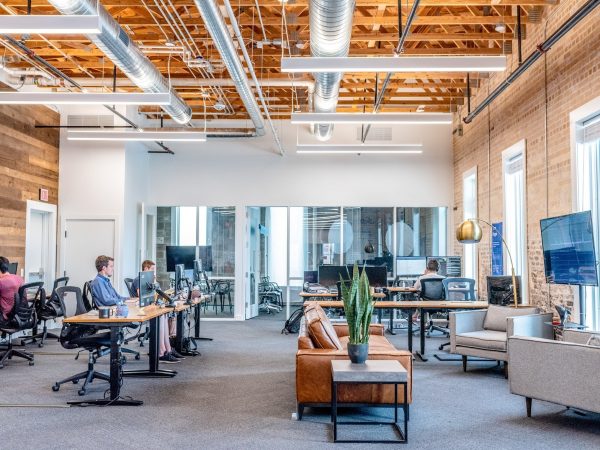
The design of an office space goes beyond aesthetics; it’s a pivotal factor that influences creativity and productivity at work. A well-thought-out office design not only caters to the physical comfort of its users but also significantly impacts their mental well-being and efficiency. An optimal workspace design fosters an environment conducive to creativity, aiding in the flow of ideas and enhancing overall work performance.
By understanding and implementing strategic design elements, you can transform an ordinary office into a hub of inspiration and productivity, where both employees and business ideas can flourish.
Table of Contents
The Role of Color
Color psychology plays a critical role in office design, affecting mood, mental clarity, and overall productivity. Different colors evoke different responses; for instance, blue is often associated with stability and calm, making it ideal for tasks requiring focus and mental strain. Green, known for its soothing properties, can reduce eye strain and promote comfort during long working hours.
For areas that demand energy and creativity, yellow can invigorate space and stimulate the mind. Choosing the right color scheme is crucial in creating an environment that enhances both creativity and concentration, making the workspace not just functional but also psychologically supportive.
Ergonomic Design
Ergonomic design in the workplace is essential not only for comfort but also for long-term health and enhanced productivity. Proper ergonomic furniture supports the body’s natural posture and reduces the risks of work-related injuries such as carpal tunnel syndrome, back pain, and eye strain. When selecting solutions, consider adjustable chairs that provide good lumbar support, desks that cater to different working positions (sitting or standing), and keyboard trays that encourage wrist health.
Accessories like ergonomic mouse pads and monitor stands can also make significant differences, ensuring that daily tasks are performed in comfort, thereby increasing efficiency and focus.
Personal Touches and Motivation
Personalizing your workspace can significantly enhance motivation and emotional connection to your work environment. Incorporating elements that reflect personal tastes and achievements, such as artwork, family photos, or mementos from personal milestones, can make the space more inspiring and comfortable.
Additionally, creating a vision board can be a powerful motivational tool. Placing symbolic items like ornamental and aspirational degrees from fake transcript makers to represent future goals or aspirations on your vision board can serve as a daily visual reminder of your targets, encouraging continuous effort and reinforcing the drive to achieve set objectives. This personalized approach not only enhances the aesthetic appeal of your workspace but also supports a positive, motivated mindset.
Natural Elements and Lighting
Integrating natural elements and optimizing lighting in office design not only beautifies the space but also offers substantial health benefits. Plants, for example, are not just decorative; they help purify the air and can reduce workplace stress and fatigue. Natural light is particularly crucial—it enhances mood, energy levels, and mental health, significantly impacting productivity and well-being.
To maximize the benefits of natural light, position workspaces near windows or design layouts that enhance light penetration. For areas with limited natural light, consider high-quality LED lighting that mimics daylight, providing a bright, evenly lit environment that supports optimal work performance.
Clutter Management and Organization
A clutter-free and well-organized workspace is pivotal in maintaining focus and enhancing productivity. Clutter can distract and overwhelm, leading to reduced efficiency and increased stress. To combat this, adopt effective organizational solutions such as using drawer organizers, filing systems, and digital tools to keep documents and supplies in order.
Utilizing vertical space with shelves can help free up desk space, while labeled bins ensure that everything has its place. Regularly decluttering your workspace by discarding unused items or digitizing documents can also help maintain a clear, focused environment conducive to productive work sessions.
Technology and Connectivity
Technology plays a crucial role in enhancing productivity in modern workspaces. Effective connectivity and the use of smart office gadgets, such as wireless charging stations, smart speakers, and dual monitors, can streamline work processes and foster a more efficient environment. However, managing technology properly is essential to ensure it aids productivity rather than becoming a distraction.
Organize digital tools and applications to minimize unnecessary notifications, and encourage the use of productivity apps that can help manage tasks and time. Ensuring robust internet connectivity and implementing cloud storage solutions can also enhance collaboration and access to information.
Flexible Spaces and Break Areas
In today’s dynamic work environment, having flexible spaces that accommodate both collaborative projects and individual-focused work is vital. Designing workspaces with movable furniture and adjustable settings allows employees to customize their work areas as needed, promoting both comfort and productivity.
Additionally, dedicated break areas are crucial for mental and physical well-being; they provide a space to relax and recharge away from work tasks. Well-designed break areas equipped with comfortable seating, relaxing activities, or even a small garden can significantly boost employee morale, stimulate creativity, and prevent burnout by offering a much-needed respite during the workday.
Recap
Creating a productive and creative office space involves much more than aesthetic appeal—it requires thoughtful consideration of color, ergonomics, natural elements, clutter management, personalization, technology, and flexible space design. Each of these elements plays a crucial role in enhancing both productivity and well-being in the workplace.
By reassessing and potentially redesigning your workspace with these principles in mind, you can transform your environment into one that not only supports your professional tasks but also promotes a healthier, more inspiring work experience. Embrace the opportunity to make your office a place where creativity and productivity flourish together.